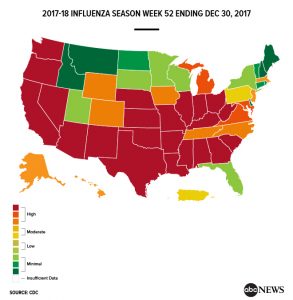One of the worst flu seasons is at an all-time peak this month – medical officials say this is as bad as it should get…
CDC official on why the flu is near-epidemic, peaking early this year
Here are three things to know:
1. The dramatic spike in flu cases
- Dr. Daniel B. Jerigan, head of the CDC’s Influenza Division, joined “GMA” to address growing concerns about this year’s near-epidemic flu strains.
“What we’re seeing this year the influenza season started earlier and seems to be peaking right about now,” Jernigan, director of the Influenza Division in the National Center for Immunization and Respiratory Diseases (NCIRD) at CDC, told “GMA.””That’s about a month earlier than it normally would be peaking,” he said, “so lots of cases [are] happening, in lots of states, all at the same time.”
Weather conditions, as well as holiday travel, could have increased the spread of this year’s flu, which is showing higher numbers at an earlier time.
“The virus was able to start circulating in time so that, when folks went home for Thanksgiving or they went home for Christmas, they were able to transmit it to the folks that they’re with,” Jernigan said. “Because of that, it’s able to circulate quickly. But we know this particular virus does cause more cases and it can be more severe.”
2. This year’s flu is different
Jernigan said this year’s flu cycle has included more cases of the H3N2 strain of the virus, influenza A, which is usually more severe and difficult to contain.
“Whenever [H3N2] shows up, it causes lots of disease, lots of hospitalizations, lots of cases and lots of deaths,” he said.
Over the past couple of years, H3N2 had not been as prevalent.
3. The effectiveness of the flu vaccine
“We know that the influenza vaccine is the best way to prevent, but in this season it is not as effective as it is for the other viruses that circulate,” Jernigan said.
Though a recent study raised the idea that the vaccine could be only 10 percent effective against this year’s flu, he said that number does not necessarily apply to the U.S. or to other strains of the flu that are circulating, besides H3N2.
“The 10 percent is a very low estimate that came out of Australia over their season last summer,” Jernigan said. “The same kind of virus that we had last year was around 30 percent to 33 percent effective for the H3 component. It’s actually more effective for the other parts of the vaccine that are trying to prevent the other flus circulating.”
Be aware and practice these steps to avoid getting the flu or to avoid spreading the flu:
Take everyday preventive actions to stop the spread of germs.
- Try to avoid close contact with sick people.
- While sick, limit contact with others as much as possible to keep from infecting them.
- If you are sick with flu-like illness, CDC recommends that you stay home for at least 24 hours after your fever is gone except to get medical care or for other necessities. (Your fever should be gone for 24 hours without the use of a fever-reducing medicine.)
- Cover your nose and mouth with a tissue when you cough or sneeze. Throw the tissue in the trash after you use it.
- Wash your hands often with soap and water. If soap and water are not available, use an alcohol-based hand rub.
- Avoid touching your eyes, nose and mouth. Germs spread this way.
- Clean and disinfect surfaces and objects that may be contaminated with germs like the flu.
Find more information on the CDC website:
https://www.cdc.gov/flu/consumer/prevention.htm
Remember that the KIOSK is available on the Floyd campus for online access to a doctor if you need to determine if your flu-like symptoms are the flu. Contact Emily Farmer in Human Resources: 706-802-5479; efarmer@highlands.edu
